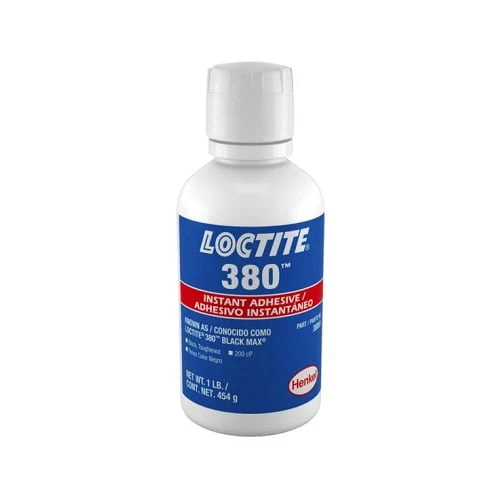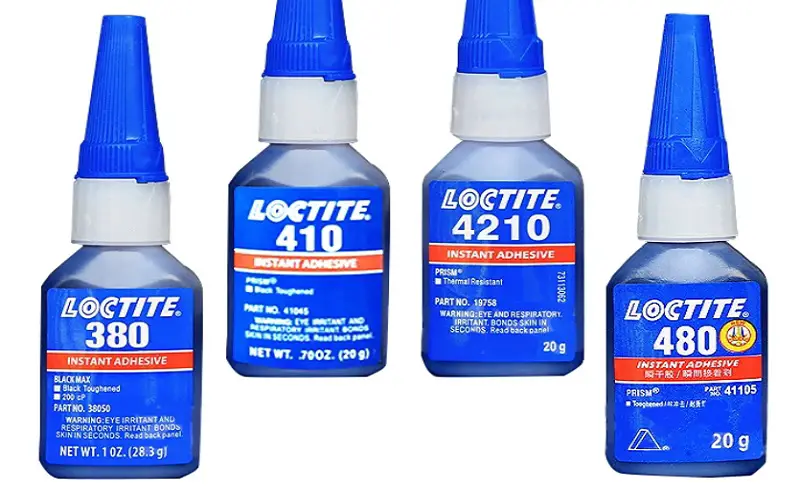Loctite 380 and 480 are both adhesives, but they serve different purposes. Loctite 380 is a black, rubber-reinforced adhesive that provides excellent bonding results for a variety of surfaces, including metals, plastics, and rubbers.
On the other hand, Loctite 480 is a clear, transparent adhesive that is specifically designed for bonding clear or colored plastics. Both adhesives offer high strength and fast curing times, making them ideal for various industrial applications.
Contents
Loctite 380
Loctite 380 is a high-performance black-colored adhesive, known for its exceptional bonding capabilities and versatility in various applications.
It provides reliable and durable bonding solutions, making it a popular choice for many professionals in different industries.
Features And Characteristics
- Strong Bonding: Offers exceptional adhesion to a wide range of substrates.
- Fast Cure: Exhibits rapid curing properties, enabling quick and efficient assembly processes.
- Temperature Resistance: Withstands elevated temperatures, ensuring stability and durability in challenging environments.
- Chemical Resistance: Provides resistance to various chemicals, enhancing the longevity of bonded materials.
Applications And Best Uses
Automotive Industry: Ideal for sealing and bonding components in automotive assembly or repair applications.
Electronics: Suitable for electronic component assembly and bonding due to its electrical insulation properties.
Industrial Machinery: Used to bond metal, plastic, and rubber components in industrial equipment maintenance and manufacturing.
Loctite 480
The Loctite 480 is a high-performance adhesive known for its superior bonding capabilities and versatility.
Features And Characteristics
- Dries clear for a seamless finish
- High strength with excellent chemical resistance
- Fast curing time for quick results
- Temperature resistance up to 120°C
- Low viscosity for easy application
Applications And Best Uses
- Industrial assembly and repair projects
- Electronic components bonding
- Automotive applications for secure sealing
- Metal and plastic bonding tasks
- Jewelry and crafts projects requiring strong adhesion
Comparison
When comparing Loctite 380 and 480, it’s important to consider their specific applications and characteristics. Loctite 380 is ideal for bonding plastics, whereas Loctite 480 is designed for metals and rubber.
Understanding the differences ensures the right adhesive for your needs. When it comes to choosing the right adhesive for your project, it’s important to consider the specific requirements and characteristics of each product.
In this comparison, we will focus on two popular Loctite adhesives: Loctite 380 and Loctite 480. These adhesives have their own strengths and differences, and understanding them will help you make an informed decision for your application.
Strength And Durability
Both Loctite 380 and Loctite 480 offer impressive strength and durability, making them suitable for a wide range of bonding applications.
Loctite 380 is a high-strength rubber-based adhesive that provides excellent bonding performance for materials such as metal, rubber, and plastics. Its exceptional bonding capabilities make it ideal for applications requiring high impact resistance.
On the other hand, Loctite 480 is a high-viscosity cyanoacrylate adhesive that offers superior strength and durability.
Its advanced formula ensures a fast and reliable bond, making it suitable for applications requiring a quick setting time and exceptional performance on a variety of substrates.
Chemical Resistance
Both Loctite 380 and Loctite 480 demonstrate impressive chemical resistance, ensuring long-lasting and reliable bonds in various environments.
Loctite 380 exhibits excellent resistance to a wide range of chemicals, including oils, fuels, and solvents. This quality makes it an ideal choice for applications where exposure to harsh chemicals is a concern.
Similarly, Loctite 480 offers exceptional chemical resistance, making it suitable for applications in demanding environments where exposure to chemicals and harsh solvents is frequent.
Curing Time
The curing time of an adhesive is an essential consideration for time-sensitive projects. Both Loctite 380 and Loctite 480 offer quick curing times, ensuring efficient workflow and productivity.
Loctite 380 has a relatively short curing time, typically reaching handling strength within 1 to 4 hours, depending on the application and environmental conditions.
Loctite 480, on the other hand, offers an even faster curing time. It typically reaches handling strength within seconds, allowing for immediate handling and reducing overall project waiting times.
Overall, when choosing between Loctite 380 and Loctite 480, consider the specific bonding requirements of your project. If you require high impact resistance and exceptional bonding performance, Loctite 380 may be the right choice.
For applications that demand quick setting time and superior strength on a variety of substrates, Loctite 480 is an excellent option. Regardless of your choice, both adhesives offer excellent strength, durability, chemical resistance, and efficient curing times.

Choosing The Right Adhesive
Loctite offers a range of adhesives, each with unique features and benefits. Among them, Loctite 380 and 480 stand out as reliable options for various bonding applications. When it comes to selecting the most suitable adhesive, it is essential to understand the differences between Loctite 380 and 480 to make an informed choice.
Considerations For Selecting Between Loctite 380 And 480:
Loctite 380 (Black Max) is known for its quick cure time and excellent gap-filling capabilities. On the other hand, Loctite 480 offers low viscosity, making it ideal for applications requiring precise bonding.
- Loctite 380 is recommended for bonding metals, rubber, and plastics due to its high strength and resistance to impact and vibration.
- Loctite 480, with its fast fixture time, is suitable for delicate substrates and electronic components, ensuring precise alignment during the bonding process.
| Criteria | Loctite 380 | Loctite 480 |
|---|---|---|
| Cure Time | Quick | Fast |
| Viscosity | High | Low |
| Recommended Substrates | Metals, Rubber, Plastics | Delicate Substrates, Electronic Components |
| Strength | High | – |
Best Practices
When choosing between Loctite 380 and 480, it’s crucial to consider your specific application needs. While Loctite 380 provides excellent chemical and temperature resistance, Loctite 480 offers faster fixture time and high strength on metals.
Ensuring a thorough evaluation of the bonding requirements is essential for determining the best fit for your project.
Tips For Optimal Application And Performance
When it comes to using Loctite adhesives, following best practices is key to ensuring optimal application and performance.
Here are some important tips to keep in mind:
- Always clean the surfaces that will be bonded with Loctite 380 or 480 thoroughly, removing any dirt, oil, or grease.
- Apply the adhesive sparingly, as excessive amounts can lead to weak bonds and longer curing times.
- Make sure to apply the adhesive evenly across the surface to ensure consistent bonding.
- Take note of the recommended curing time for the specific adhesive you are using, as this can vary between Loctite 380 and 480.
- It’s important to allow sufficient curing time for the adhesive to develop its full strength. Avoid applying any stress or load on the bonded parts until the recommended curing time has passed.
- Store the adhesive according to the manufacturer’s instructions, ensuring proper temperature conditions and shelf life.
Comparing Loctite 380 And 480 – Best Practices
If you are trying to decide between Loctite 380 and 480, it is important to consider the best practices for each adhesive.
Here is a quick comparison to help you make an informed choice:
| Loctite 380 | Loctite 480 |
|---|---|
| Suitable for bonding metal, ceramic, and plastic substrates. | Suitable for bonding metal, ceramic, plastic, and rubber substrates. |
| Offers excellent corrosion resistance and high strength. | Provides excellent resistance to harsh environmental conditions. |
| Ideal for applications requiring temperature resistance up to 120 degrees Celsius. | Suitable for applications requiring high temperature resistance up to 150 degrees Celsius. |
| Cures at room temperature within 24 hours. | Provides faster curing at room temperature within 1-3 hours. |
Considering these best practices and the specific characteristics of each adhesive, you can choose the one that best suits your bonding needs.
Remember to always refer to the product datasheets and instructions provided by Loctite for detailed information on application and performance.

Frequently Asked Questions Of Loctite 380 Vs 480
What Is Loctite 480 Used For?
Loctite 480 is used for bonding and sealing electronic components and connectors. It provides a strong and durable bond, making it ideal for use in the automotive, aerospace, and industrial sectors.
What Is Loctite 380 Used For?
Loctite 380 is used for bonding cylindrical fitting parts, particularly where high-temperature resistance is required. It is ideal for applications that need to withstand high temperatures and rigorous environments.
How Strong Is Loctite 380?
Loctite 380 is a strong adhesive that provides excellent bonding strength for various materials. It is known for its reliability and durability in bonding applications.
How Long Does It Take Loctite 380 To Set?
Loctite 380 typically sets in about 10 to 15 minutes. It cures quickly for efficient bonding.
Conclusion
Both Loctite 380 and 480 are robust adhesives suitable for various applications. However, choosing the right one depends on your specific needs and project requirements.
Understanding the differences between these two products is crucial for achieving optimal bonding results. Make an informed decision based on your unique situation.

